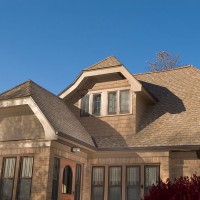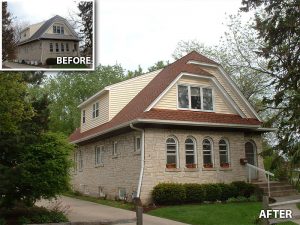 by Mike Wood
by Mike Wood
At Callen, we know that a roof is one of the most important home-related investments you’ll make. We do dozens of roofing projects each year, and we see the dramatic impact and improvement that comes from upgrading a home’s roof.
However, we have also seen that roofs are one of the most neglected parts of the home’s exterior after they have been replaced. Just as you keep your lawn watered and trimmed, your roof requires maintenance to help prolong its life and ultimately save you money.
Caring for your roof doesn’t need to be difficult or time-consuming if done regularly and correctly. Callen suggests following these steps to help your roof reach its anticipated life span.
1. Remove Debris
Removing debris to prevent water buildup since pine needles and tree limbs can prevent the roof from properly shedding water, plus debris adds weight to the roof that can eventually cause sagging or even failure. Bird droppings and certain types of leaves and/or pine needles can eat away at the roof, causing premature aging.
Use a push broom to sweep debris from the roof, but avoid using a broom with hard bristles because it may remove an excessive amount of asphalt granules from the shingles. You can also spray off the roof with a garden hose. Avoid using a power washer because a high-pressure stream of water can damage most any type of roof, even putting dents in metal roofing.
2. Trim Back Tree Limbs
Trim tree branches that appear to be on the verge of falling on the roof. If you notice water collecting in a particular area, or if water damage is already visible, it may be because tree limbs are blocking the sun from properly drying the roof. Consider pruning trees to help control water drainage issues.
3. Remove Algae and Fungus
Algae, moss, and fungi can grow on virtually any type of roof, even roofs designed to prevent it. Remove the growth by mixing equal parts bleach and water in a sprayer and applying it to the affected areas.
Once the roof is cleared, installing a zinc strip near the roof ridge can prevent future problems. As rainwater runs over these strips, the zinc particles are absorbed in the water, which then coats the roof with a protective layer.
These strips are easy to install by sliding them about an inch under a line of shingles near the ridge and nailing them down with galvanized nails. Apply a little sealant to each nail head to protect against leaks.
4. Snow and Ice Removal
With a roof rake, clear heavy snow and ice from the roof, as snow and ice can put stress on a roof structure, so do your best to keep the roof free and clear of ice dams, icicles, and heavy snow.
 5. Clean the Gutters
5. Clean the Gutters
Clear leaves, sticks, and shingle granules from gutters to prevent clogs. Gutters can only handle so much weight before failing. Trapped water in your gutters are also a popular breeding ground for pesky mosquitos.
6. Apply Roof Cement to Lifted Shingles
If you notice raised shingles, you may be able to solve the problem with roofing cement. Just apply a little to the underside of the lifted shingle, and it should help it lay flat. Not addressing this problem can lead to future water damage and blown off shingles with the next heavy storm.
7. Remove Standing Water
Brush or squeegee puddled water from the rooftop. This is particularly important if you have a flat roof and/or the roof gets little direct sunlight during the day.
Once ponding water is cleared from the roof, try to determine its cause (i.e., roof pitch is incorrect, tree limbs shade the roof all day, roof is sagging, etc.). If necessary, have a roofing contractor visit, as fixing the problem early can save money down the road.
8. Inspect Flat Roofs for Cracks, Blistering, and Seam Failure
Flat roofing products should be checked at least once a year for cracking and blistering, paying special attention to the seams where water tends to sneak under the roofing material. For small holes or cracks, use a roofing sealant for the repair.
9. Roof Flashings
The majority of roof leaks occur because of damaged or improperly installed flashing. Inspect the flashing around vents and chimneys to ensure a watertight seal. If minor damage is noticed, apply polyurethane sealant to help keep the water out.
10. Inspect Seals around Skylights
The seals around skylights can wear out over time, so inspect the seals for damage. If necessary, have a contractor re-apply sealant made specifically for skylights.



Leave a Reply